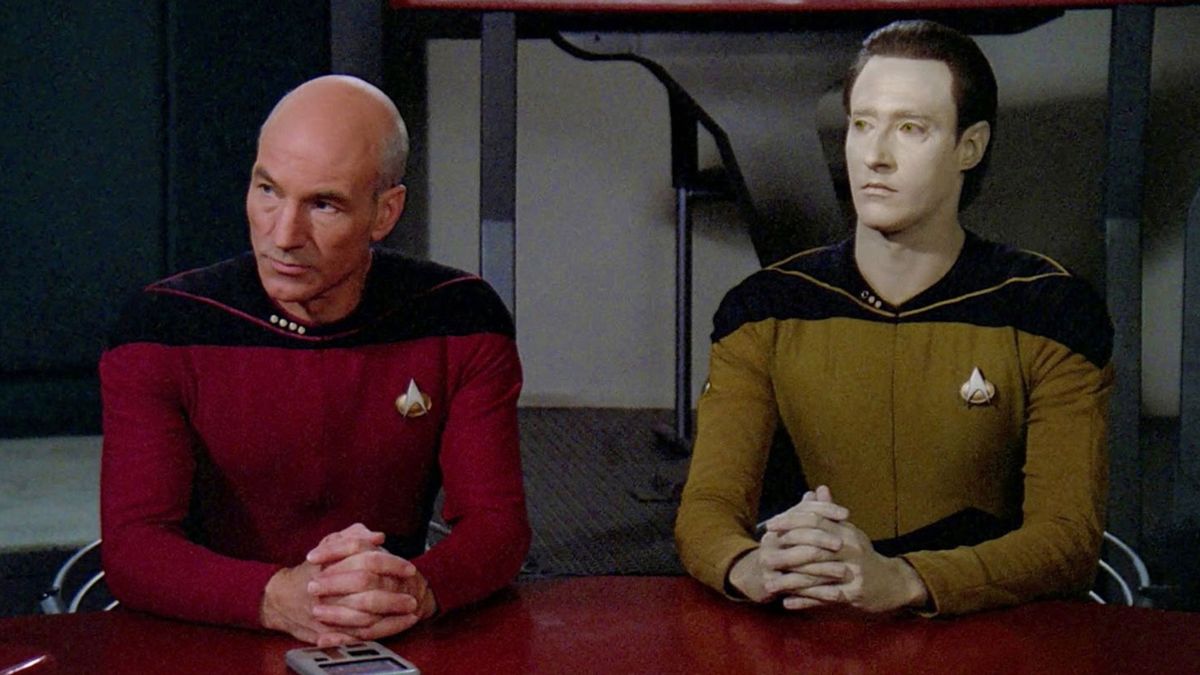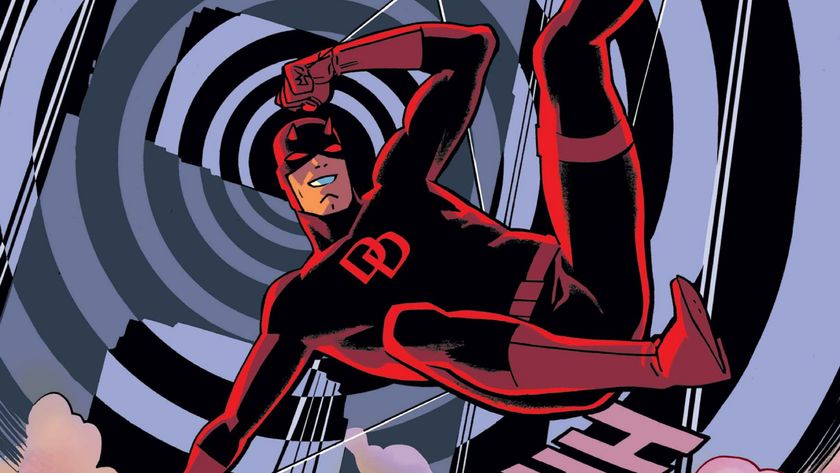Star Trek: Picard: Data may be dead, but he could be the series' most important character
Spoilers for Star Trek: Picard episode 1 ahead

Star Trek: Nemesis caused two major casualties. The first was the Trek movie series – a combination of a critical mauling and a lukewarm box office put the films on ice until J.J. Abrams’ 2009 reboot finally saw the Enterprise blast back into cinemas. The second was the beloved Lt. Commander Data, who nobly sacrificed himself to save his legendary captain, Jean-Luc Picard, during the movie.
While Ol’ Yellow Eyes may be gone, the android crewman is certainly not forgotten. In fact, his circuitry is so hard-wired into the new Next Generation follow-up Star Trek: Picard that he may well turn out to be the most important character in the show. Sorry, Jean-Luc...
If there’s one thing that Star Trek has taught us over eight TV shows and 13 movies, it’s that death isn’t necessarily the end – especially if you’re a key member of a starship’s bridge crew. Boldly going has a long history of resurrection.
Famously, Spock returned from the final final frontier via the creative use of a Vulcan mind-meld, while the Kelvin timeline version of James T. Kirk managed a similar feat in Star Trek into Darkness thanks to Khan’s magic blood. Jadzia Dax may have been bumped off in Deep Space Nine, but the consciousness of the slug-like Dax symbiont lived on in a new host, Ezri. And even Tasha Yar, murdered in cold blood in The Next Generation’s first season, managed to reappear in an alternative timeline.
Despite being on the wrong end of an exploding Romulan thalaron generator in Nemesis, Data's return was inevitable. After all, the movie made damn sure it gave Data a lifeline when he downloaded his consciousness into his prototype "brother" B-4, and director Stuart Baird even went as far as having the last scene in Nemesis being Jean-Luc telling B-4 about his fallen comrade. Hint, hint...
Fast-forward two decades to Star Trek: Picard and Data exists in his former captain’s dreams. While the android may not be there in body, however, the key themes of the new show seem tied into what, and who, Data was. The first episode even gives us a great big signpost by playing Irving Berlin’s “Blue Skies” – the song Data performed at Riker and Troi’s wedding in Nemesis, and subsequently taught B-4 – over the opening scene. Not a bad legacy for a character who now resides in silicon heaven.
In 'life' Data was unique (well, almost – but we’ll get on to that later). Created by genius cyberneticist Dr. Noonian Soong, Data’s positronic brain was light years ahead of any other artificial intelligence in the Federation. He was super-strong, super-fast, and had more processing power than a billion iPhones (rough guess). Despite being superior in many regards, he spent his life aspiring to be more human – and, in Star Trek: Generations, he finally developed emotions, courtesy of a special chip constructed by Soong years earlier.
Sign up for the Total Film Newsletter
Bringing all the latest movie news, features, and reviews to your inbox
These are crucial details to remember while watching Picard, a show set in an era where a group of 'synthetics' killed thousands of people on Mars, leading to androids being outlawed in the Federation. Despite the ban, the show’s first episode reveals that Dahj and her twin sister on the Romulan/Borg Cube are synthetic organisms so advanced that they’re made of flesh and blood – and could pass for human. In other words they’re "Data’s daughters".

They’re not supposed to exist, either by law or by science. We learn at the Daystrom Institute in Okinawa (a top research facility frequently mentioned in The Next Generation, named after A.I. pioneer Richard Daystrom from Original Series episode “The Ultimate Computer”) that the technology required for them to function is impossible in the 25th century. In fact, research scientist Dr. Agnes Jurati tells Picard that such machines are at least 1000 years away – unless someone had access to Data’s positronic brain, or one like it. If that were the case, assembling the new tech would be a relatively straightforward process. (In short, the fact that Data has been reduced to atoms is massively inconvenient.)
According to Jurati, A.I. expert Dr. Bruce Maddox was working on so-called "fractal neronic cloning" (bear with the Technospeak – it is Star Trek) until he went on the run following the synthetic uprising. Intriguingly, Maddox is no newcomer to Trek. In classic TNG episode “The Measure of a Man”, Maddox arrives on the Enterprise looking to disassemble Data. His aim? To find out what makes Data tick so he can construct more androids like him. After a barnstorming courtroom performance from Picard, however, it’s decreed that Data is a sentient being and not the property of Starfleet. Remarkably, there’s no bad blood between Data and Maddox afterwards, and they continue to correspond throughout The Next Generation.
It’s well known that Data always wanted a child of his own: in TNG episode “The Offspring” he creates Lal, an artificial lifeform who, despite being even more advanced than himself, dies prematurely from an overload in her positronic brain. This idea is emphasised by the fact that a piece of artwork in Picard’s vault featuring Dahj’s face (painted 30 years before Star Trek: Picard kicks off) is simply titled "Daughter". It’s reasonable to assume, then, that Data would have been involved in the creation of these new twin 'daughters' – especially as they are modelled after the face of the woman in the painting.
The question is, how involved was Data? Did he take the lead on the research that created the twins, or was Maddox the driving force? If Data was working closely with Maddox back in the day, that would explain how the scientist had (at least early) access to the functioning Soong-type positronic brain he needed to push the boundaries of artificial intelligence. But there’s another alternative source that could make Star Trek: Picard more intriguing – a higher risk strategy that could potentially make the Data connection even more important to the show.
We know of two other functioning androids like Data. The first is B-4 (be-fore), the useless prototype model who was introduced in Star Trek: Nemesis. He’s such a poor shadow of his brother that, as Jurati explains, most of the information Data downloaded into him was lost in his inferior neural network. He is definitely not what Maddox used to create the twins.
The other option is rather more sinister – Data’s evil twin, Lore.

While Lore never took the traditional bad sibling route of wearing a goatee beard, in all other respects he was bad news – an egotistical psychopath with little regard for humanity. After several run-ins with the Enterprise, he was dismantled and boxed in TNG’s season seven opener “Descent: Part 2”. It wouldn’t be a stretch of the imagination to guess that a parcel and its messed-up contents somehow found his way to the Daystrom Institute and/or Maddox – and that Lore’s circuitry went on to form the basis of Dahj and her sister.
This would be an intriguing twist for Star Trek: Picard. Could Lore’s wonky programming have introduced a glitch into the twins’ own systems? Is he on the loose somewhere, waiting to get his revenge on Jean-Luc Picard. If so, was he somehow involved in the aforementioned android uprising? Aside from giving the returning Brent Spiner a little more to do than simply appear in Picard’s dreams, the return of Lore is bound to shake things up.
Consider that Data and Lore have nearly as much history with the Borg as the formerly assimilated Jean-Luc Picard – could they, therefore, be the missing link between the artificial intelligence plot and the Borg strand of the story? The cybernetically enhanced Borg Queen was obsessed with the contradiction of Data’s existence – the machine who wanted to be human. Meanwhile, Lore once led (and exploited) a faction of rogue Borg who’d discovered the concept of individuality. That faction’s leader, Hugh, is back in Star Trek: Picard, so any interaction with Lore would undoubtedly be fraught with tension. Fear of Lore may also be the reason that Romulan assassins, clearly somehow connected to the Borg, were so fixated on killing Dahj.
Although it’s Jean-Luc Picard who gives his name to the new show, it looks like the narrative thrust of Star Trek: Picard will instead be provided by another iconic Next Generation character. Data’s digital fingerprints are already all over the series – just how far his programming spreads will hopefully be revealed over the coming weeks…
Need a refresher before continuing with Picard? Then it's worth watching these 10 key Star Trek: The Next Generation episodes.
Star Trek: Picard is now available on CBS All Access in the U.S. and Amazon Prime Video in the U.K. New episodes debut on Thursdays (US) and Fridays (UK).
Richard is a freelancer journalist and editor, and was once a physicist. Rich is the former editor of SFX Magazine, but has since gone freelance, writing for websites and publications including 12DOVE, SFX, Total Film, and more. He also co-hosts the podcast, Robby the Robot's Waiting, which is focused on sci-fi and fantasy.
Most Popular






